abot79-2


Seedlings of the compass plant, Silphium laciniatum, in a restored prairie on the Iowa State University campus, Ames, Iowa. All seedling leaves are facing the same direction (east).
abot79-6


Variation among flowers of the Mimulus guttatus complex (Scrophulariaceae). Top row, M. guttatus; middle row, M. platycalyx; bottom row, M. nasutus.
abot79-6a

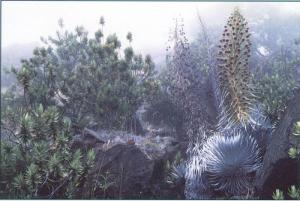
Flowering rosette of the extremely rare Mauna Kea silversword (Argyroxiphium sandwicense subsp. sandwicense growing with a shrubby or tree-like member of the Hawaiian silversword alliance (Dubautia arborea) at about 2,950 m elevation. In spite of great morphological differences (including unbranched monocarpic rosette shrubs, highly branched polycarpic shrubs, trees, and vines), virtually all 28 species in the three genera constituting the silversword alliance retain the ability to hybridize, and many striking hybrid combinations are produced in nature.
abot79-12


(Left) functional male flower of Echinocereus coccineus (Cactaceae) showing pollen-filled anthers surrounding the base of the stigma lobes. (Right) Functional felmale flower of E. coccineus from a different plant showing reduced filaments and empty anther sacs held below the stigma lobes.
abot80-2

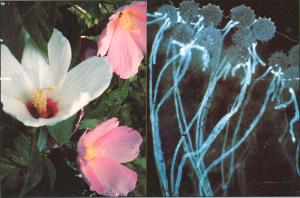
Wild rose mallow (Hibiscus moscheutos): flowers at left; close-up view of stigma at right, where excess pollen grains typically deposited by bees germinate and the resulting pollen tubes must compete for ovules.
abot80-12

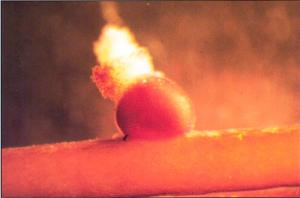
An aspect of red algal reproduction illustrated by the release of diploid spores from a cystocarp of Gracilaria verrucosa.
abot81-1


At left, female (top) and hermaphrodite (bottom) flower of bladder campion (Silene vulgaris); their nectaries differ in production of sugar content. At right, a European skipper (Thymelicus lineola) removes nectar from a female bladder campion flower. Differences in nectar production between the genders of plants may affect pollinator activity and, ultimately, indbreeding.
abot81-3


Vigorous spring growth of introduced Spartina alterniflora on a mud flat in South San Francisco (California) Bay. This invasive grass threatens to reduce shorebird feeding areas and clog flood control channels. Individual genetic clones, seen as distinct circular patches, have highly variable seed set, which will probably influence the future genetic composition of this population.
abot81-5

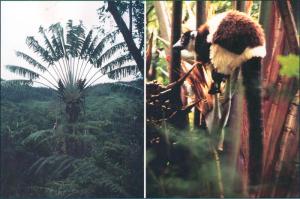
Distichous phyllotaxy (left) is a distinctive feature of Ravenala madagascariensis (Strelitziaceae) by lemurs in Madagascar: evidence for an archaic coevolutionary system?
abot81-7


A lesser long-nosed bat, Leptonycteris curasoae, approaching a flower of the columnar cactus, Pachycereus pringlei. The abundance of this pollinating bat is a key factor in the maintenance of trioecy in this cactus.
abot81-9

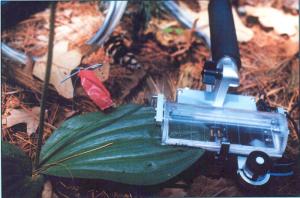
Infrared gas analyzer being used in the field to measure the photosynthetic rate of a leaf of pink lady's slipper orchid.
abot81-10

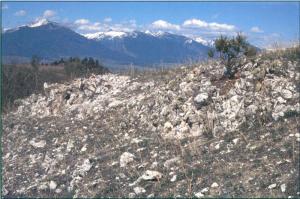
The Bitterroot Valley of western Montana, showing a typical habitat for the rare species, Arabis fecunda: dry and rocky with erodible, sparsely vegetated slopes. This species has a mixed mating system and exhibits inbreeding depression, attributes of reproductive biology that may complicate efforts to preserve its populations.
abot81-11

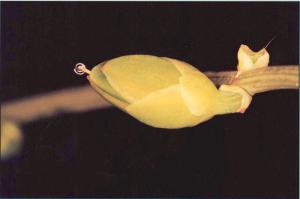
Pollination droplet secreted from tip of slender micropylar tube of Ephedra ovule. Pollen adheres to the sticky, sugar-rich droplet, which later retracts to allow pollen to germinate in the pollen chamber adjacent to the female gametophyte.
abot82-2

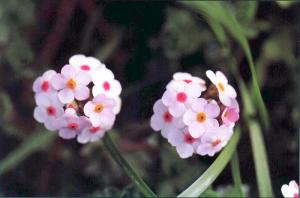
The central yellow ring of a young Androsace lanuginosa (Primulaceae) flower turns red over several days, while the rest of the flower remains fresh and unchanged. The color presumably signals the plant's fly pollinators, which visit only rewarding,yellow-phase flowers. Such floral color changes occur in at least 77 families in 33 orders.
abot82-6


A unisexual (early male) umbel of Bomarea acutifolia, a hummingbird-pollinated vine in the mountains of Costa Rica. Following the male phase, each flower continues to produce nectar during a week-long neuter phase and then becomes female. Thus, each umbel is temporally unisexual and opportunities for self-pollination are limited.
abot82-9


Group of Calypso bulbosa (Orchidaceae) from the rocky Mountain foothills west of Calgary, Alberta, Canada. After receiving pollen, these flowers undergo rapid changes in color and shape, but the rate of change is unaffected by the amount of pollen deposited. Removal of a flower's own pollen does not cause color or shape changes.
abot83-2

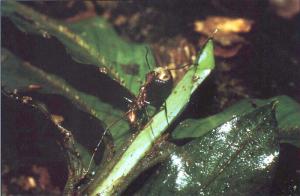
A myrmicine ant, Aphaenogaster araneoides, carrying a seed of a neotropical understory herb, Calathea micans (Marantaceae). Ant-planted chasmogamous and cleistogamous seeds differed in establishment success in understory and gap sites.
abot83-4


Cross section of Lilium at the tetrad stage stained with the PAS polysaccharide specific reaction. Soluble carbohydrates are detected within the locular fluid and the tapetum, whereas starch grains are accumlated in the outer anther wall layers (epidermis, endothecium, and middle layers).
abot83-9

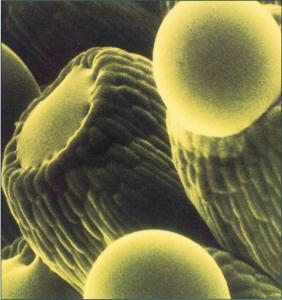
Pollination drops inside an ovulate cone of Sequoiadendron. These drops persist undisturbed during wet periods, since a water sheet forms on the wettable cone surface. Pollen capture resumes immediately after the cone dries.
abot84-2

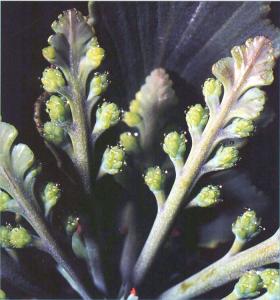
Pyllocladus glaucus Carr. (Phyllocladaceaes), Toatoa or Blue Celery Pine, endemic to New Zealand, showing part of a pseudowhorl of fertile phylloclades. Cones are borne marginally towards the base of these modified branch complexes. The individual ovules with pollination drops are at the stage of pollen receptivity. Magnification x5, from a color transparency by J. E. Braggins.
abot84-4


A capitulum of the South African "beetle daisy" (Gorteria diffusa: Asteraceae). The dark raised spots on the ray florets are strikingly similar to the bee-fly (Megapalpus nitidus: Bombyliidae) that pollinates this plant. Experiments show that bee-flies are more strongly attracted to capitula with spots than capitula in which spots have been removed.
abot84-8


Flow visualizations (rose bengal dye in top view; milk in bottom view) around three carpellate flowers of Zostera marina in a flow chamber at an ambient velocity of ~2 cm/s.
abot85-6


The common sunflower, Helianthus annus L., from the Garden of the
Gods in Colorado Springs, Colorado.
abot86-1


The dung beetle Paragymnopleurus pauliani (Scarabaeidae) is visiting the zygomorphic flower of Orchidantha inouei (Lowiaceae), presumably being attracted to the dung-like odor of the flower.
abot86-5

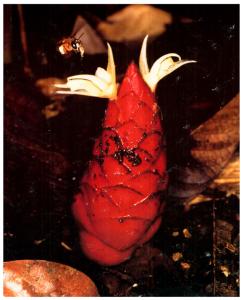
In the dark forest understory, white flowers of the ginger Zingiber longipedunculatum are pollinated by pollen-collecting female Amegilla bees (Anthophoridae). Ginger species in a Bornean forest show high diversity, but they were grouped into only three pollination guilds.
abot86-6

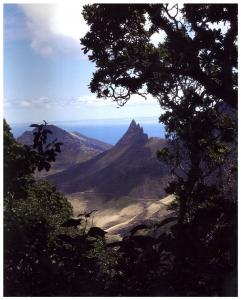
View of "Tres Picos" (Three Peaks) from Villagra on Robinson Crusoe Island, which is in the Juan Fernandez archipelago off the coast of Chile. The closer vegetation represents the habitat for Lactoris fernandeziana (Lactoridaceae).
abot86-8


Inflorescence with flowers of purple loosestrife, Lythrum salicaria (left panel). Depending on the relative length of styles with respect to stamens within flowers, individuals are categorized into three floral morphs. The three floral morphs also differ in size and shape of stigmas (right panel). Stigmas (top–long morph, middle–mid morph, and bottom–short morph, in the right panel; bar = 200 µm) are digitally false-colored computer-enhanced images from scanning electron micrographs. Photo credit: M. Biernacki, T. K. Mal, R. J. Williams, and The Camera Shop, Broomall, Pennsylvania.
abot87-1


Color-enhanced scanning electron photomicrograph of a seed of Lobelia inflata (Campanulaceae). The seed's actual width is ~0.30 mm. An individual of this monocarpic and self-fertilizing species typically produces 50–100 fruits, each containing up to 500 seeds. This species has a strict light requirement for germination.
abot87-6


White-lined moth (Hyles lineata) and bumble bee (Bombus pennsylvanicus sonorus) foraging on Agave palmeri in a wild population near Fort Huachuca, Arizona.
abot88-9

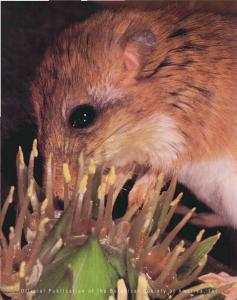
A nocturnal rodent, Gerbilluris paeba, feeds on the copious amounts of jelly-like nectar produced by flowers of the African lily Massonia depressa (Hyacinthaceae). This lily, which has flowers situated at ground level, is the first monocotyledon discovered to be pollinated by rodents. The striking similarities between the flowers of M. depressa and those of unrelated rodent-pollinated Protea spp. (Proteaceae) provide strong support for the concept of convergent floral syndromes.
abot90-5


Pollen germination and tube growth in the snow buttercup, <IT>Ranunculus adoneus,</IT> photographed under fluorescence microscopy. Snow buttercup flowers exhibit heliotropism, the capacity to track the sun's rays over the course of the day. The adaptive significance of solar tracking in snow buttercups is mediated through the impact of flower heliotropism on paternal and maternal floral environments. In controlled crosses, pollen from solar-tracking flowers has higher germination success than pollen from experimentally restrained flowers. Solar tracking in recipient flowers also enhances pollen germination and increases pollen tube to ovule ratios.
abot90-8

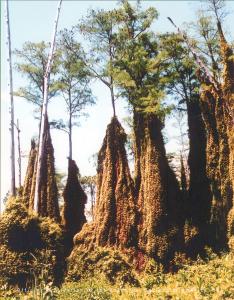
A severe infestation of <IT>Lygodium microphyllum</IT> (Cav.) R. Br. located at Jonathan Dickinson State Park, Martin County, Florida, USA. A native of the Old World tropics, <IT>L. microphyllum</IT> has become a serious pest in the forested wetlands of South Florida since naturalizing in the 1960s. Within severe infestations, this vine-like fern can smother both the understory and canopy, disrupting the recruitment of native vegetation and altering local fire ecology. The spread of this species appears to be facilitated by its ability to reproduce via intragametophytic selfing.
abot87-8

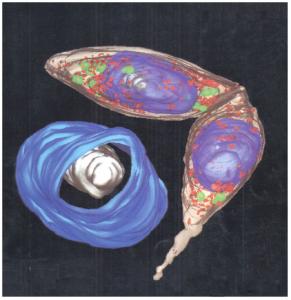
Computer-generated three-dimensional reconstruction of the male germ unit of rye (Secale cereale) based upon serial ultrathin sections. The two elongated sperm cells are connected at one end and each contains some plastids (green), as well as numerous mitochondria (red) and a nucleus (blue). The vegetative nucleus (blue) is closely associated with the sperm cells, but not connected; it contains a single nucleolus (white).
abot92-3

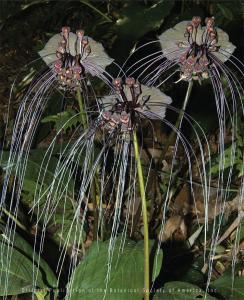
Tacca chantrieri in the shady understory of a tropical forest in Yunnan Province, China. The striking floral display involves dark-purple pigmented flowers and bracts, and extended whisker-like bracteoles. In Tacca, these traits have been assumed to function as a deceit syndrome in which reproductive structures resemble decaying organic material attracting flies that facilitate cross-pollination (sapromyiophily). However, experimental studies of the pollination and mating biology of T. chantrieri in China cast doubt on this hypothesis by demonstrating that most seed produced in populations is the result of autonomous self-pollination.
abot95-09

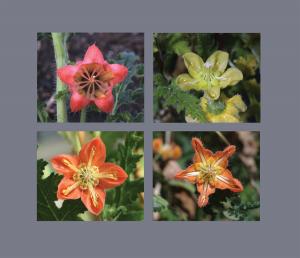
Flowers of three Peruvian species of Caiophora (Loasacae subfam. Loasoideae)
and a natural hybrid (bottom left: C. cirsiifolia C.Presl